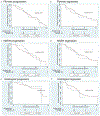Association of Components of Metabolic Syndrome and the Progression of Nonalcoholic Fatty Liver Disease
- PMID: 40163040
- PMCID: PMC12584972
- DOI: 10.14309/ajg.0000000000003455
Association of Components of Metabolic Syndrome and the Progression of Nonalcoholic Fatty Liver Disease
Abstract
Introduction: The effects of metabolic syndrome (MetS), its individual components, and baseline liver histology, on the rates of progression and regression of nonalcoholic fatty liver disease (NAFLD), were evaluated.
Methods: We conducted a post hoc analysis of a multicenter prospective cohort study using the noninterventional registry of the Nonalcoholic Steatohepatitis Clinical Research Network (2002-2022). We included patients aged 18 years or older with biopsy-proven NAFLD. Outcomes included progression/regression of histology defined by changes in NAFLD Activity Score, nonalcoholic steatohepatitis, or fibrosis. Crude incidence rates were compared among patients with MetS vs those without using Kaplan-Meier curves and log-rank test. Cox proportional hazard models were used to estimate effects of MetS and its components on the fibrosis progression/regression.
Results: We included 452 patients; the mean age was 51 years, one-third was male, and 85% was White. The median follow-up was 4.3 (range: 1-15.6) years. At baseline, patients with MetS, large waist circumference, and impaired glucose tolerance/diabetes had worse ballooning and fibrosis scores and a higher prevalence of definite nonalcoholic steatohepatitis than those without. MetS was not associated with fibrosis progression or regression. Impaired glucose tolerance/diabetes was associated with a higher risk of fibrosis progression (adjusted hazard ratio = 1.61; 95% confidence interval: 1.11-2.34) whereas hypertension was associated with a lower risk (adjusted hazard ratio = 0.64; 95% confidence interval: 0.43-0.96).
Discussion: In the cohort of patients with NAFLD, MetS was associated with greater histological severity at baseline but was not a risk factor of disease progression or regression. Impaired glucose/diabetes was associated with a higher rate and hypertension with a lower rate of fibrosis progression.
Keywords: disease progression; metabolic syndrome; nonalcoholic fatty liver disease; nonalcoholic steatohepatitis.
Copyright © 2025 by The American College of Gastroenterology.
Conflict of interest statement
S.D. is funded by grants NIH R01 GM119174; R01 DK113196; P50 AA024333; R01 AA021890; 3U01AA026976; U01 AA 026976; R56HL141744; U01 DK061732; 5U01 DK062470-17S2; R21 AR 071046 which are independent of the submitted work.
CONFLICTS OF INTEREST
Figures

References
-
- Riazi K, Azhari H, Charette JH, et al. The prevalence and incidence of NAFLD worldwide: A systematic review and meta-analysis. Lancet Gastroenterol Hepatol 2022;7(9):851–61. - PubMed
-
- Younossi ZM, Koenig AB, Abdelatif D, et al. Global epidemiology of nonalcoholic fatty liver disease—Meta-analytic assessment of prevalence, incidence, and outcomes. Hepatology 2016;64(1):73–84. - PubMed
-
- En Li Cho E, Ang CZ, Quek J, et al. Global prevalence of non-alcoholic fatty liver disease in type 2 diabetes mellitus: An updated systematic review and meta-analysis. Gut 2023;72(11):2138–48. - PubMed
-
- Quek J, Chan KE, Wong ZY, et al. Global prevalence of non-alcoholic fatty liver disease and non-alcoholic steatohepatitis in the overweight and obese population: A systematic review and meta-analysis. Lancet Gastroenterol Hepatol 2023;8(1):20–30. - PubMed
-
- Younossi ZM, Golabi P, de Avila L, et al. The global epidemiology of NAFLD and NASH in patients with type 2 diabetes: A systematic review and meta-analysis. J Hepatol 2019;71(4):793–801. - PubMed
Grants and funding
- R56 HL141744/HL/NHLBI NIH HHS/United States
- U01 DK061732/DK/NIDDK NIH HHS/United States
- U01 DK061718/DK/NIDDK NIH HHS/United States
- UL1 TR000006/TR/NCATS NIH HHS/United States
- R01 AA030970/AA/NIAAA NIH HHS/United States
- U01 AA021890/AA/NIAAA NIH HHS/United States
- UL1 TR000436/TR/NCATS NIH HHS/United States
- R01HS026937/Agency for Healthcare Research and Quality Safety Program for Telemedicine
- U01 DK061728/DK/NIDDK NIH HHS/United States
- U01 DK061738/DK/NIDDK NIH HHS/United States
- UL1 TR000448/TR/NCATS NIH HHS/United States
- P50 AA024333/AA/NIAAA NIH HHS/United States
- R01 HS026937/HS/AHRQ HHS/United States
- U01 DK061737/DK/NIDDK NIH HHS/United States
- UL1TR000439, UL1TR000436, UL1TR000006, UL1TR000448, UL1TR000100, UL1TR000004, UL1TR000423, UL1TR002649/National Center for Advancing Translational Sciences (NCATS)
- U01 DK061713/DK/NIDDK NIH HHS/United States
- UL1 TR002649/TR/NCATS NIH HHS/United States
- U01 DK062470/DK/NIDDK NIH HHS/United States
- R01 GM119174/GM/NIGMS NIH HHS/United States
- R21 AR071046/AR/NIAMS NIH HHS/United States
- U01 DK061730/DK/NIDDK NIH HHS/United States
- U24 DK061730/DK/NIDDK NIH HHS/United States
- U01 AA026976/AA/NIAAA NIH HHS/United States
- UL1 TR000439/TR/NCATS NIH HHS/United States
- U01 DK061734/DK/NIDDK NIH HHS/United States
- R01 DK113196/DK/NIDDK NIH HHS/United States
- UL1 TR000423/TR/NCATS NIH HHS/United States
- UL1 TR000100/TR/NCATS NIH HHS/United States
- U01DK061713, U01DK061718, U01DK061728, U01DK061732, U01DK061734, U01DK061737, U01DK061738, U01DK061730, U24DK061730/DK/NIDDK NIH HHS/United States
- UL1 TR000004/TR/NCATS NIH HHS/United States
LinkOut - more resources
Full Text Sources

